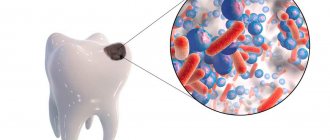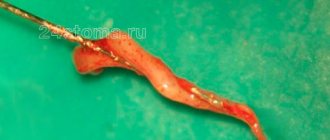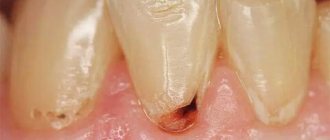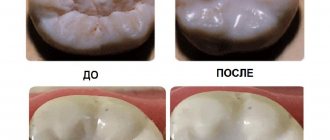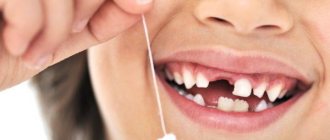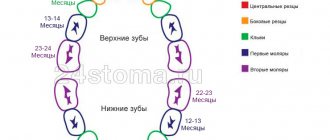No matter how careful you and your child are, tooth injury can happen out of the blue.
Thin or weakened enamel can cause teeth to break when simply biting on hard foods. Part of the tooth may break off, exposing dentin with or without exposure of the pulp (the nerve of the tooth).
A baby’s tooth can break in different places: at the top of the root, in the middle or at its base; In case of injury, tooth displacement is also possible.
Main types of dental injuries:
- tooth bruise;
- partial chipping of the tooth crown;
- partial or complete dislocation of a tooth;
- tooth root fracture of varying degrees of complexity;
- mixed types of injuries, etc.
Why a baby tooth may break off - possible reasons
Before we get into what to do if a baby tooth chips, it's worth considering the potential causes of the injury. For example, in children under 2 years of age, the most common traumatic factor is careless handling of toys when trying to “taste” them. An equally risky period is learning to eat independently using cutlery. The baby can easily miscalculate the force and accidentally hit the crown on a spoon or the edge of a cup.
The cause of the breakdown may be careless handling of hard objects.
If a tooth breaks off in a child aged 5 years or older, this is usually preceded by a fall or blow, again received during play or active activities. Dietary habits also play an important role. For example, if a child is used to chewing icicles, does not carefully bite off solid foods, and often eats crackers and chips, the risk of injury in his case will be much higher.
Certain circumstances also create suitable conditions for injury:
- carious processes - lead to the appearance of a cavity that rapidly grows, as a result of which the enamel weakens and quickly collapses,
- hypoplasia and other non-carious lesions - fragmentary or even complete (aplasia) absence of enamel, its obvious underdevelopment,
- malocclusion - uneven distribution of the chewing load leads to constant excessive impact on individual elements, as a result of which they are destroyed over time,
- abnormal position of the teeth - the presence in a row of strongly curved elements protruding beyond the alveolar arch, more susceptible to injury.
Caries of baby teeth can also cause breakage.
One cannot ignore such a fairly common phenomenon as bruxism. Children with this diagnosis involuntarily clench their jaws and grind their teeth during sleep. As a result, the enamel quickly wears off and becomes sensitive - hyperesthesia develops. Thus, bruxism creates optimal conditions for the appearance of chips and cracks.
Obviously, the weaker and thinner the enamel, the higher the likelihood of damage occurring on it. If we consider the problem from this perspective, then many endocrine disorders, acute deficiency of calcium and other important minerals in the body, and congenital anomalies also lead to the depletion of the external protective layer.
What if a child has a broken tooth?
First, it is important to understand how serious the situation is? If the front baby tooth is broken at the root, the dentist will most likely recommend removing it. If only a piece of a tooth (deciduous or permanent) has broken off, then removal can be avoided and an attempt can be made to restore it. The pediatric dentist will use filling material or an artificial crown to restore the missing part of the tooth. With severe trauma, the tooth may go deep into the gums (the so-called “impacting”), and initially it may seem that the child has broken the tooth at the very root. Therefore, it is very important to contact your pediatric dentist immediately. If the injury was so severe that the entire tooth fell out of the socket (knocked out), then, if possible, you need to find the tooth and get an appointment with the dentist as soon as possible, taking the knocked out tooth with you. In most cases, permanent teeth can be “implanted” in their original place (replanted). The knocked-out tooth must be placed in warm milk or saline solution, or directly into the child’s mouth, and the sooner your child is in the dentist’s chair, the higher the likelihood of such a tooth being implanted (the clock counts). Baby teeth cannot be replanted.
Classification of chips and associated symptoms
Dental experts classify chips according to severity. So, a chip of enamel is a minor damage that affects only the top layer. The patient may not experience any pain or discomfort at all.
A chip of enamel is a minor damage
Sometimes the injury affects the dentin, and under it there is a pulp chamber with a bundle of blood vessels and nerve endings. If the damage also affects the pulp, the child will feel severe piercing pain. In such a situation, emergency medical attention is required.
The photo shows teeth with dentin and pulp trauma
A root fracture is a serious injury that can result from a strong blow or fall. The crown breaks, but the root remains inside. With such damage, there is a serious risk of injury to the rudiments of permanent incisors and canines. In all of the above cases, you need the advice and help of a specialist. In this case, the method of treatment and restoration will directly depend on the degree of damage to the visible part and internal structures of the tooth.
Fracture – serious injury to a tooth
The following symptoms often indicate injury - pay attention to them:
- there are complaints of increased sensitivity or the child makes it clear by his behavior that he is experiencing discomfort. He may refuse hot and cold foods, avoid sweets and sour foods, try to chew on one side,
- if the damage reaches the pulp, severe piercing pain occurs,
- discomfort may intensify at night, and this also indicates injury to the pulp,
- Many children acquire the habit of “searching” with their tongue behind their cheek, as if there was something in the mouth.
Severe pain may indicate damage to the pulp.
If you notice one or more of the symptoms described above in a child, ask him, find out if his teeth are bothering him. And be sure to show your baby to a specialist.
Types of chipped teeth
Restoration methods depend on the damage. Dentists distinguish the following types of chipped teeth:
- Incomplete. A barely noticeable crack appears on the enamel, and the rest of the tooth is not affected. The easiest case, which requires purely aesthetic restoration.
- Enamel chip. If a small piece breaks off from a tooth, most likely only the enamel is damaged. If measures are taken quickly, the deep layers of the tooth will not have time to collapse either.
- Dentin chipping. This layer is located under the enamel, inferior to it in hardness, but reliably protects the nerve and pulp. If dentin is damaged, the tooth usually does not hurt; at most, it reacts to acids and cold.
- Chip exposing the pulp. If a tooth is severely cracked, its darker part is visible, and the person is in pain, this means that the pulp, the most sensitive part of the tooth, is damaged. This is where the nerve and blood vessels are located, so bleeding is common. If the pulp is chipped, you need to make an appointment with a doctor as soon as possible. However, when half a tooth chips off, people usually do not postpone the visit.
When should you go to the dentist?
Immediately after receiving an injury, parents need to pull themselves together and try to calm the baby. The first thing you need to do is make a visual inspection, try to carefully clean the oral cavity from food debris, ask the child to rinse his mouth with boiled water at room temperature or a light antiseptic solution. To relieve the pain a little and reduce swelling, you can apply ice wrapped in several layers of napkins to the cheek on the side of the sore spot. If bleeding occurs, apply a piece of sterile bandage to the wound and immediately go to the doctor.
The first step is to ask your child to rinse his mouth.
What complications can there be?
If the chip is minor and does not cause discomfort, this does not mean that you can ignore it. Damage will lead to further destruction of hard tissues, and then dentin and pulp will be at risk. If the neurovascular bundle is damaged, the child will inevitably experience severe piercing pain, and further treatment may require removal of the nerve.
In addition, the presence of injured elements in the oral cavity creates favorable conditions for the proliferation of bacteria and infection of tissues. In addition to serious dental problems, this can lead to the development of diseases of the liver and kidneys, digestive and cardiovascular systems.
Crown fracture without pulp exposure with enamel damage (B) (S02.50)
In this case, the enamel chips, which is most often localized at the corners of the front teeth. Clinical manifestations of the injury include pain when exposed to heat and the possibility of cutting the tongue with sharp edges. Redistribution of the crown within the enamel is easily diagnosed during a visual inspection. The tooth maintains mobility within the physiological norm and demonstrates positive percussion. X-ray studies in this case usually show the preservation of bone tissue and roots, and an electrical excitability test shows the vital activity of the pulp. Treatment for chipped enamel is carried out as follows:
- rough and sharp edges are well ground and treated with fluorine compounds;
- enamel is restored using modern composite materials (fillings);
- Dispensary observation of the functional state of the pulp is carried out.
Treatment methods - what can be done in dentistry
Now let’s move on to the question of what to do if a child’s piece of a baby tooth breaks off. If this is a one-year-old baby, seek help from a specialist as soon as possible. The doctor will assess the severity of the injury and suggest the best solution to the problem. You may need to undergo x-ray diagnostics and additional examinations. At this stage of development of the body, it is important to make sure that the baby does not have systemic disorders that could lead to a deterioration in the condition of hard tissues and their destruction.
“Many thanks to the doctors of your clinic! My daughter is 4 and a half, she damaged her tooth while playing with other children. Your crown was completely restored for us, very quickly, efficiently and completely without stress for the child. Now she always goes to the dentist in a great mood! Everything is very professional and kind. Thank you for such a correct approach to working with children!”
Valentina V.D., fragment of a review on the website of one of the Moscow dental clinics
If we talk about older children, then if chips of enamel or dentin appear, the dentist can perform a composite build-up to hide the defect. If the cause was caries, the doctor will remove the affected tissue and put a filling. A restoration insert may be required to hide large chips. It looks like a large filling, but it is created from impressions in a separate laboratory. In order to strengthen and saturate the enamel with useful microelements, a course of fluoridation and remineralization is prescribed.
For minor defects, dental treatment is performed
It’s another matter when the pulp or root is damaged during an injury. In the first case, the nerve is removed and the tooth is then restored using a pin. If the root is severely damaged, the tooth is completely removed. And if you wait even more than a year before changing the primary bite, the doctor is obliged to offer temporary prosthetics for this period. Otherwise, even one primary incisor or molar, removed ahead of schedule, can lead to displacement of the rows and curvature of the bite1.
The photo shows teeth after prosthetics
Dental care for chips
Modern dentistry has the necessary materials to prevent the destruction of a chipped tooth and to restore it. The treatment option is selected by the dentist based on the location of the tooth and the complexity of the problem.
Possible options:
- Restoration using a filling made of light-curing composite materials; used for minor chips, applicable for both chewing and front teeth.
- Ceramic inlays are a modern alternative to fillings; they allow you to completely restore the shape and activity of the tooth, do not shrink, and do not wear off; recommended for tooth decay of more than 50%; they are not used in the restoration of chewing teeth.
- Installation of veneers on teeth - ceramic inlays on the front surface and cutting edge of the tooth; Ideal for restoring dentition in the smile area, they are used when it is impossible to restore with a filling.
- Installation of a crown - performed in case of significant damage to the tooth, when the pulp chamber is affected; installation is carried out after removal of the nerve and treatment of the canals. To restore chewing teeth, durable metal-ceramic or zirconium structures can be used; for chipped front teeth, ceramic crowns are preferred.
What experts advise for prevention
As in the case of any other pathological conditions, it is always better to prevent unpleasant consequences than to later engage in long and costly, and sometimes quite painful, treatment. To reduce the risk of damage and destruction of children's primary incisors and molars, it is necessary from an early age to teach the child to take a responsible approach to oral care, brush his teeth every morning and evening, and follow all basic hygiene rules.
It is worth keeping a close eye on your baby while he is playing. Try to exclude all traumatic factors. Later, if the child begins to engage in traumatic sports, he should be given an individual protective mouthguard - this service is provided by many modern dentists.
It is worth keeping a close eye on your baby while he is playing.
But finally, in no case should you ignore any pathological changes in the oral cavity, even if there are only temporary baby incisors and molars. If there is a clear malocclusion, orthodontic treatment should be started promptly. If caries and inflammatory processes develop, immediately show the child to a specialist. Parents need to remember that any advanced dental diseases can easily damage the buds of permanent teeth, which will inevitably affect their condition and health in the future.
1Eradze E.P., Osipov G.A. Modern methods of treating acute dental trauma in children, 2001.
Causes of enamel cracks in children
The main condition for the appearance of an enamel crack is an impact that exceeds its safety factor. This can happen either when it becomes thinner or due to very severe trauma (both instantaneous and regular). The list of the most common causes of pathology includes:
- blows falling on the tooth area;
- the habit of chewing candy, nuts and other hard foods, as well as opening bottles with teeth, etc.;
- use of pastes with a large number of abrasive components;
- deficiency of vitamins and minerals, leading to thinning of the enamel;
- bruxism: grinding teeth while sleeping;
- dental errors when treating caries and performing other manipulations;
- abuse of products that corrode enamel (certain types of soda, fruit, etc.);
- wearing braces;
- poor oral care;
- orthodontic problems leading to uneven load on the dentition during chewing.
